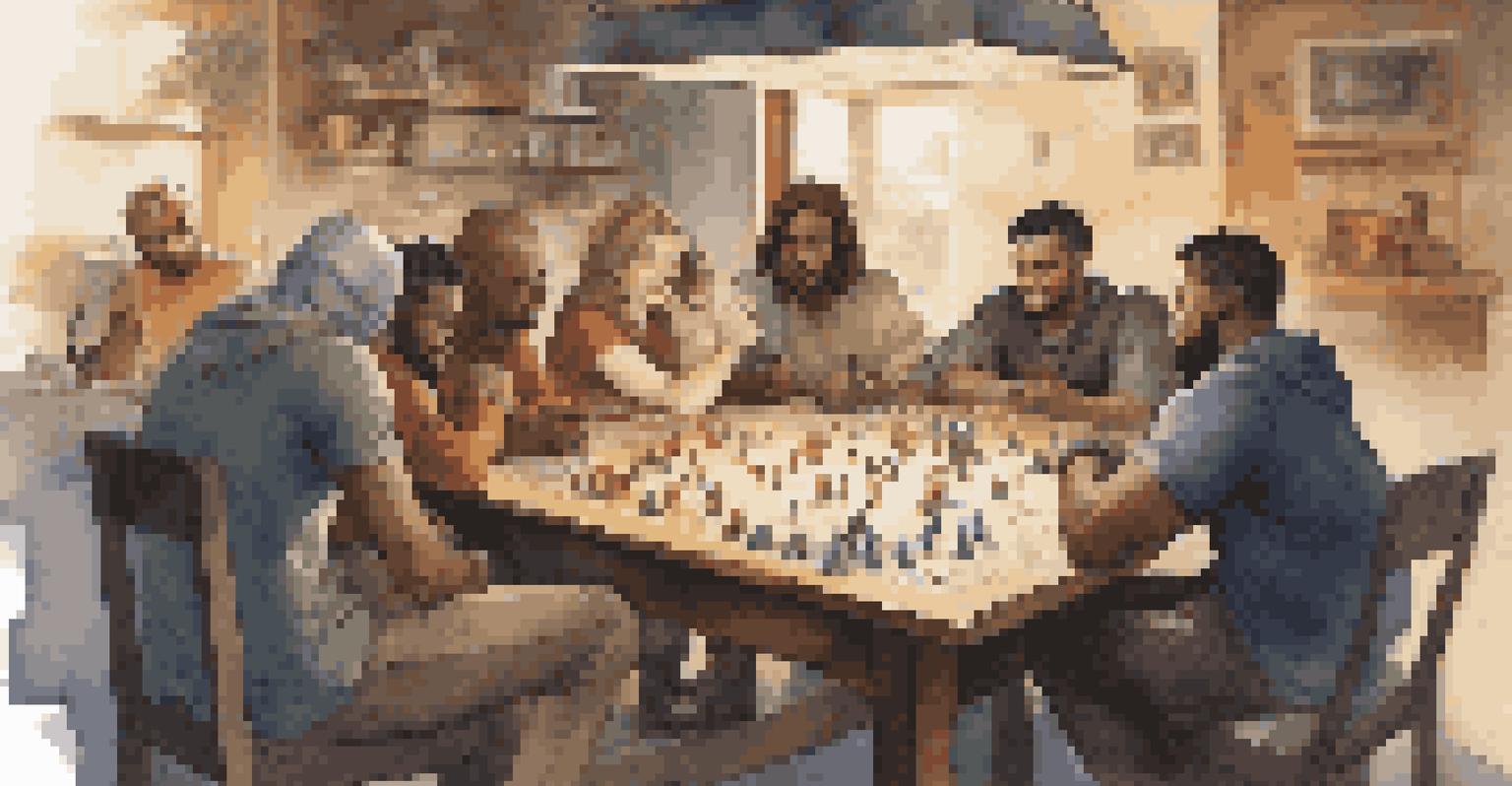The Evolution of Gaming Narratives: Past to Present

The Dawn of Gaming: Simple Stories and Gameplay
In the early days of gaming, narratives were almost non-existent. Games like 'Pong' and 'Space Invaders' focused primarily on gameplay mechanics, with little to no storyline. Players were more concerned with achieving high scores than unraveling intricate plots.
Games have always been a way to tell stories, and the evolution of narratives in gaming reflects our own growth as individuals and communities.
As technology advanced, so did the ability to tell stories. The introduction of text-based games, such as 'Zork', allowed players to engage with narratives in a way that was not possible before. This shift marked the very beginning of storytelling in gaming, where players could make choices that influenced their journey.
These early narratives were straightforward, often revolving around quests or simple conflicts. Yet, they laid the groundwork for what was to come, sparking curiosity and interest in deeper stories that would soon follow.
The Rise of 8-Bit and 16-Bit Narratives
As gaming evolved into the 8-bit and 16-bit eras, the narratives became more elaborate. Classic titles like 'Super Mario Bros.' and 'The Legend of Zelda' introduced characters and worlds that players could connect with. These games combined engaging gameplay with charming stories, making them memorable.

The limitations of hardware pushed developers to be creative with storytelling. For instance, 'Final Fantasy' emerged as a pioneer in role-playing games (RPGs), featuring rich character arcs and emotional storylines. Players were no longer just battling monsters; they were embarking on epic adventures filled with twists and turns.
Gaming Narratives Evolve Over Time
From simple mechanics to complex stories, gaming narratives have significantly progressed, engaging players in deeper, more immersive experiences.
This era marked a significant shift where players started to care about story outcomes. The combination of graphics, sound, and narrative led to a more immersive experience that captivated audiences and set the stage for future storytelling.
Narratives in the 3D Revolution: Immersion and Depth
The transition to 3D gaming in the late 1990s and early 2000s brought a massive shift in storytelling. Games like 'Final Fantasy VII' and 'The Legend of Zelda: Ocarina of Time' showcased the potential of 3D environments, allowing for more complex plots and character development. Players could explore vast worlds and engage with narratives on a deeper level.
Video games are a unique medium that can convey complex narratives and emotions in ways that traditional storytelling cannot.
This era also saw the rise of cinematic storytelling in games. Titles like 'Metal Gear Solid' and 'Halo' integrated cutscenes that felt like movies, enhancing emotional engagement. Players experienced a blend of gameplay and narrative that kept them on the edge of their seats.
The 3D revolution not only changed how stories were told but also how players interacted with them. It was no longer just about the end goal; players were now invested in the story, forming attachments to characters and their journeys.
Narrative Complexity: The Age of Choices and Consequences
With the advent of choice-driven games, narratives became more complex and personal. Games like 'Mass Effect' and 'The Walking Dead' introduced branching storylines where player decisions had meaningful impacts on the outcome. This shift allowed players to shape their own narratives, creating a sense of ownership over their gaming experience.
These games emphasized character development, moral dilemmas, and emotional depth. Players found themselves grappling with tough choices, leading to a more profound connection to the characters and their stories. This emotional engagement redefined what it meant to be a player, transforming them into active participants in the narrative.
Player Choices Shape Story Outcomes
Modern games emphasize player agency, allowing decisions to impact the narrative, leading to a more personalized gaming experience.
As narratives evolved, players began to expect more from their gaming experiences. The desire for choice and consequence became a hallmark of modern gaming, pushing developers to innovate and create even more intricate storylines.
Indie Games: Unique Narratives and Bold Experimentation
The rise of indie games has introduced fresh perspectives on storytelling in gaming. Titles like 'Journey' and 'Celeste' showcase how smaller studios can craft unique narratives that resonate deeply with players. These games often prioritize emotional experiences over traditional gameplay mechanics, leading to innovative storytelling techniques.
Indie developers frequently experiment with narrative structure, using unconventional methods to tell their stories. For instance, 'Undertale' plays with player expectations and genre conventions, creating a narrative that feels both familiar and entirely new. This creativity has opened up new avenues for storytelling, encouraging players to think outside the box.
Indie games have also highlighted the power of personal stories, often drawing from the developers' own experiences. This intimate approach has fostered a sense of community among players, who can relate to the narratives on a more personal level.
The Role of Multiplayer and Community in Storytelling
As gaming has evolved, so too has the role of multiplayer experiences in storytelling. Online games like 'World of Warcraft' and 'Fortnite' have transformed narratives into collaborative experiences. Players can create their own stories together, shaping the narrative landscape in real-time.
This shift towards community-driven storytelling has led to a more dynamic form of narrative. Events within these games often unfold based on player actions, leading to unexpected outcomes and shared experiences. Players are no longer just passive consumers; they are co-authors of the story.
Indie Games Foster Unique Storytelling
Indie developers are pushing the boundaries of narrative creativity, offering emotional and innovative storytelling that resonates with players.
The blend of multiplayer and narrative has also fostered a sense of belonging among players. Communities form around shared stories, creating bonds that extend beyond the game itself. This evolution showcases the power of storytelling to connect people, making gaming a truly social experience.
The Future of Gaming Narratives: Trends and Innovations
As we look to the future, gaming narratives are poised for even greater innovation. With advancements in technology, such as virtual reality (VR) and artificial intelligence (AI), the potential for immersive storytelling is limitless. Games could evolve into experiences that adapt to individual player choices in real-time, creating uniquely personal narratives.
We may also see a continued emphasis on representation and diversity in gaming narratives. As the industry expands, there is a growing demand for stories that reflect a wider range of perspectives and experiences. This push for inclusivity can lead to richer, more relatable narratives that resonate with a broader audience.

Ultimately, the evolution of gaming narratives will continue to reflect the changing landscape of society and technology. As players seek deeper connections and engaging stories, developers will rise to the challenge, creating experiences that captivate and inspire for generations to come.